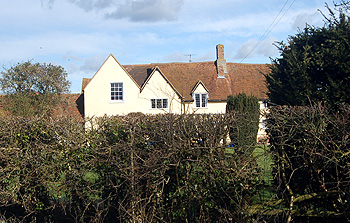Rushey Ford Farm Kempston Rural

Rushey Ford House March 2012
Rushey Ford House is a most attractive old property, listed by English Heritage in August 1987 as Grade II, of special interest. The earliest part of the house, a single bay and a cross-wing which is jettied (that is the first floor overhangs the ground floor) date from Shakespeare’s time. The south-east bay, the listing notes “is a later addition or rebuild”. Another wing was added to the north-west end of the farmhouse in the late 18th or early 19th century. The older parts of the building are timber-framed, as one would expect, and the north-west addition is brick. In the 20th century the ground floor was built out into a flat roofed extension. All the external walls have been rendered. The house has two storeys beneath an old clay tiled roof. At the same date the barn was also Grade II listed. It is 18th century in date, timber-framed and weather-boarded on a plinth of coursed limestone rubble. It has a corrugated iron roof and was listed “for group value with the house”.
The Rating and Valuation Act 1925 specified that every building and piece of land in the country was to be assessed to determine its rateable value. The valuer visiting Rushey Ford Farm [DV1/H1/82] found that the owner was Fred Ray and the occupier Richard Beaumont whose rent of £240 per annum had been set in 1924. The farm comprised 56 acres of which forty acres were woodland. The valuer commented: “A Gentleman’s small Farm with a good House and Buildings. Rent absurd. Does not farm seriously, keeps dogs in part of Homestead. Grass all mown”. Another hand has added: “Good House”.
This house comprised a hall, two reception rooms, two kitchens and a scullery with six bedrooms, a bathroom and W. C. above. Another W. C. stood outside. The valuer noted: “Water from poor well. Electric Light”. Another hand has added: “Very nice old house, original front close to farm buildings”.
These farm buildings included brick and slate loose box, stable, harness room and three further loose boxes. Brick and tiled buildings comprised a cow house for six beasts (“bad”), two loose boxes, two large barns and a chaff place. Another hand has amended this later to read: five loose boxes, two barns, a three bay hovel, a cart shed, two more barns, another three bay hovel, a granary, two loose boxes, a mixing house, eight piggeries, four piggeries and another eight piggeries, a large barn used as a garage, a garage and a coal shed. He has added: “Buildings not used”.
Directories for Bedfordshire were not published every year but every few years from the early to mid 19th century until 1940. The following occupiers of Rushey Ford Farm can be identified:
- 1914: Alfred Benjamin and Alfred Anthony Chibnall
- 1920: Frederick A. Kennedy
- 1924: Richard H. Beaumont; Alfred Benjamin and Alfred Anthony Chibnall
- 1928, 1931, 1936 and 1940: Richard H. Beaumont
On the night of 15th November 1940 the quiet of this very rural part of Kempston was shattered by enemy action. Around two hundred small incendiary bombs fell in a line from Bromham House Colony to Rushey Ford and on to Hanger Wood [WW2/AR/CO/2/2]. In 1964 the farmhouse underwent restoration and improvement [X404/36].